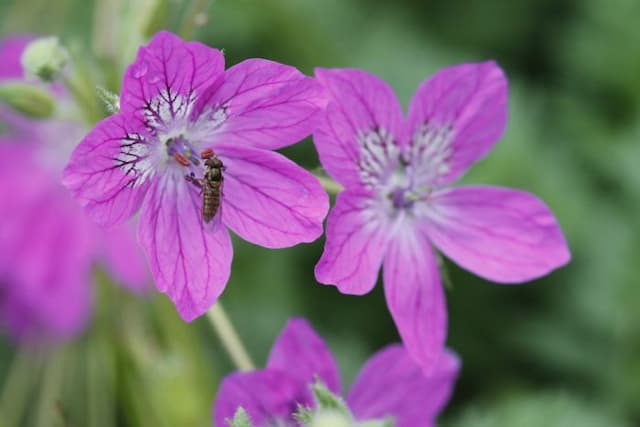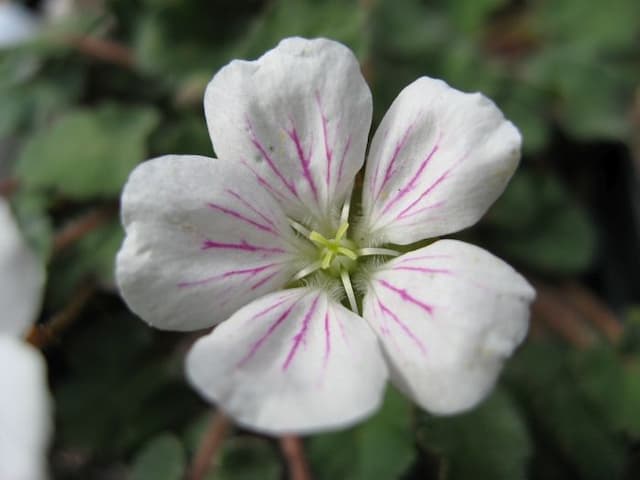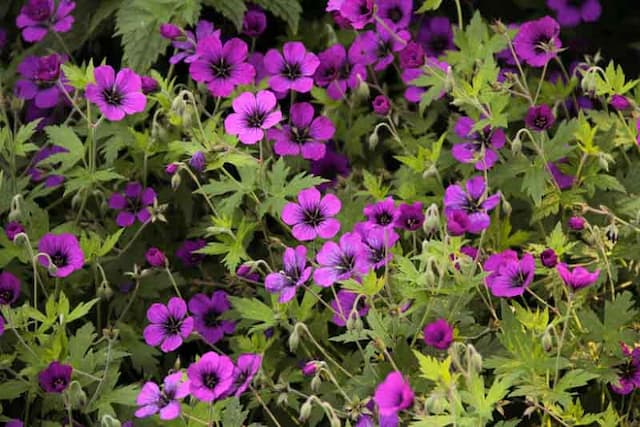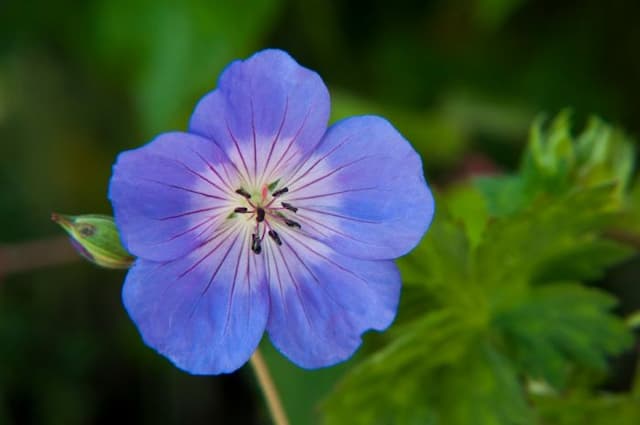Wood Cranesbill Geranium sylvaticum f. roseum 'Baker's Pink'

ABOUT
The plant commonly known as 'Baker's Pink' is a visually attractive variety adorned with showy flowers. Its blooms exhibit a delicate pink hue, which is particularly vibrant and eye-catching. The flowers are typically composed of five rounded petals, often displaying a slight vein-like pattern that adds depth and texture to their appearance. Each flower is held aloft by sturdy stems, which are surrounded by lush green foliage. The leaves of 'Baker's Pink' are notable for their shape, which can be described as somewhat rounded with a lobed or dissected appearance, giving them a rich, textured look. The foliage forms a nice backdrop to the flowers, contrasting the soft pink with a deep green that can accentuate the brightness of the blooms. Generally, this variety of geranium presents a clumping habit, forming a pleasing mound shape that can serve as a lovely ground cover or as a charming addition to garden borders. The overall impression of 'Baker's Pink' is of a hardy, yet delicate-looking plant that can add a splash of color and a touch of wild natural beauty to any garden setting.
About this plant
 Names
NamesSynonyms
Baker's Pink Geranium, Woodland Geranium, Pink Wood Cranesbill.
Common names
Geranium sylvaticum var. roseum.
 Toxicity
ToxicityTo humans
Wood Cranesbill (Geranium sylvaticum) is not considered highly toxic to humans. However, ingesting parts of the plant, especially in significant quantities, may cause mild gastrointestinal upset, including symptoms like nausea, vomiting, or diarrhea. It is always advisable to avoid eating ornamental plants, even if they are not severely poisonous, as they are not meant for human consumption.
To pets
Wood Cranesbill is also not recognized as being highly toxic to pets. Similar to humans, if pets ingest parts of this plant, they may experience mild gastrointestinal distress. Symptoms can include vomiting, diarrhea, and possibly a loss of appetite, but the plant is not expected to cause severe toxicity or long-term health problems in pets. It is always safer to prevent pets from ingesting non-food plants to avoid these potential issues.
 Characteristics
CharacteristicsLife cycle
Perennials
Foliage type
Deciduous
Color of leaves
Green
Flower color
Pink
Height
1-2 feet (30-60 cm)
Spread
1-2 feet (30-60 cm)
Plant type
Herb
Hardiness zones
4
Native area
Europe
Benefits
 General Benefits
General Benefits- Aesthetic Appeal: Adds a splash of pink color to gardens with its rose-pink flowers, brightening up the landscape.
- Attracts Wildlife: It serves as a food source for pollinators such as bees and butterflies, promoting biodiversity.
- Durability: Hardy in a variety of climates and soil types, making it a resilient choice for many gardeners.
- Low Maintenance: Requires minimal care once established, suitable for gardeners looking for low-effort plants.
- Seasonal Interest: Provides a long flowering season, offering visual interest throughout late spring and early summer.
- Garden Structure: Can be used to create borders or as ground cover, providing structure to garden designs.
- Companion Planting: Works well when planted alongside other perennials, enhancing overall garden diversity.
 Medical Properties
Medical PropertiesThis plant is not used for medical purposes.
 Air-purifying Qualities
Air-purifying QualitiesThis plant is not specifically known for air purifying qualities.
 Other Uses
Other Uses- Geranium sylvaticum, commonly known as woodland geranium, can be used for natural dyeing due to its various pigments, particularly in the petals.
- The plant's leaves can serve as a filler in floral arrangements, providing a delicate green backdrop for more colorful flowers.
- Woodland geranium is incorporated in perfumery for its subtle and pleasant fragrance as a backnote in floral scents.
- The dried leaves and petals can be used in potpourris to add a natural, earthy aroma to a room.
- Pressed flowers of the woodland geranium can be used in crafts such as card making, bookmark creation, or decoupage.
- Its vibrant blooms can be used to add visual interest to edible dishes, such as in salads, though it should be done with caution after confirming edibility.
- Woodland geranium can be planted as a companion plant in gardens to attract beneficial insects, such as bees and butterflies.
- The plant serves as a natural indicator of soil acidity; it thrives in more acidic soils, which gardeners can use as a cue for soil conditions.
- When planted in large groups, woodland geranium can be used as ground cover to help with soil erosion control.
- The strong stems of the woodland geranium can be used in basket weaving for decorative purposes.
Interesting Facts
 Feng Shui
Feng ShuiThe Wood Cranesbill, which is a common name for Geranium sylvaticum, can be used to introduce vibrant energy and promote balance in a home or garden. In Feng Shui, flowers like the Wood Cranesbill might be used to add a pop of color and life energy, known as 'chi', particularly in areas that are connected to personal growth and health, which correspond to the east sector of a space. Their blossoming nature can symbolize new beginnings and is often favored in living areas where the energy of growth and renewal is desired.
 Zodiac Sign Compitability
Zodiac Sign CompitabilityThe Wood Cranesbill is not used in astrology practice.
 Plant Symbolism
Plant Symbolism- Unexpected Meeting: Because Geraniums can pop up in various places due to their ease of cultivation, they're often associated with unexpected encounters or serendipity.
- Friendship: Geraniums are a common gift between friends, symbolizing friendship and positive emotions.
- Health: The geranium is also a symbol of good health, perhaps because it has been used in traditional medicine.
- Fertility: With its prolific blooming and growth, some cultures view geraniums as a symbol of fertility and abundance.
- Happiness and Positive Emotions: The bright and varying colors of geranium flowers are often linked to cheerfulness and maintaining a positive outlook.
 Water
WaterWood cranesbill, commonly known as 'Baker's Pink', should be watered deeply once a week, allowing the soil to dry out slightly between waterings. During the active growing season in spring and summer, ensure that you're providing about one gallon of water per square foot every week. In the fall and winter, reduce watering to half a gallon per square foot as the plant goes dormant and its water needs decrease. Avoid overhead watering to minimize the risk of leaf diseases; instead, water at the base of the plant. If rainfall is adequate, adjust your watering schedule accordingly to prevent overwatering.
 Light
LightWood cranesbill thrives best in full sun to partial shade conditions. The ideal spot for 'Baker's Pink' is one where it can receive at least four to six hours of sunlight daily. However, in hotter climates, it benefits from some afternoon shade to protect it from the intense heat.
 Temperature
Temperature'Baker's Pink' prefers moderate temperatures and can generally tolerate a range from around 55°F to 75°F, which are ideal for optimal growth. It can survive minimum temperatures down to roughly 20°F, but should be protected from frost. During hot weather, if temperatures consistently rise above 85°F, the plant may go dormant or need additional care to thrive.
 Pruning
PruningPruning 'Baker's Pink' is beneficial for promoting new growth and preventing overcrowding. Deadhead spent flowers regularly throughout the blooming season to encourage further flowering. In late fall or early spring, cut back the entire plant to about 4 to 6 inches to promote healthy, bushy growth. Pruning is typically done once a year, but deadheading can be performed as needed during the blooming period.
 Cleaning
CleaningAs needed
 Soil
SoilWood Cranesbill prefers moist, well-draining soil rich in organic matter with a pH ranging from 5.6 to 7.5. A mixture of garden soil, compost, and peat moss can create an optimal environment for this plant.
 Repotting
RepottingWood Cranesbill rarely needs repotting, but if growth has been vigorous, consider repotting every 2-3 years in early spring before new growth begins.
 Humidity & Misting
Humidity & MistingWood Cranesbill thrives in average to high humidity levels, with ambient outdoor conditions generally sufficient without the need for additional humidity control measures.
 Suitable locations
Suitable locationsIndoor
Place Wood Cranesbill in bright, indirect light and water regularly.
Outdoor
Choose partial shade, keep soil moist for optimal Wood Cranesbill growth.
Hardiness zone
3-8 USDA
 Life cycle
Life cycleGeranium sylvaticum f. roseum 'Baker's Pink', commonly known as Wood Cranesbill or Meadow Cranesbill, begins its life cycle when seeds are dispersed, typically in late summer or fall, and germinate in the soil. Seedlings emerge in the spring and establish a rosette of basal leaves. The plant undergoes vegetative growth and eventually forms a flowering stem, which can take one to a few years, depending on environmental conditions. Blooming occurs from late spring to early summer, showcasing its distinctive pink flowers that attract pollinators for sexual reproduction. After pollination, the fertilized flowers develop into beak-like seed capsules that release seeds when mature, thereby completing the cycle. The plant can also spread vegetatively through its rhizomatous root system, creating clonal colonies that persist for multiple years.
 Propogation
PropogationPropogation time
Spring-Early Summer
Propogation: The Wood Cranesbill, or Geranium sylvaticum f. roseum 'Baker's Pink', is commonly propagated in the late spring to early summer period when the weather has warmed sufficiently and the risk of frost has passed. The most popular method for propagating this hardy perennial is by division, which involves separating a mature plant into smaller sections that each contain roots and shoots. To propagate by division, carefully dig up the plant and wash or brush soil away from the roots to better see how the clumps can be divided. Using a sharp, sterilized knife or spade, cut the plant into sections, ensuring that each new piece has a portion of the root system as well as some shoots. Replant these divisions promptly into prepared soil, spacing them approximately 12 to 15 inches (30 to 38 centimeters) apart, and water them in well. This method of division allows for rapid increase of stock and helps to rejuvenate older plants that may be declining in vigor.









